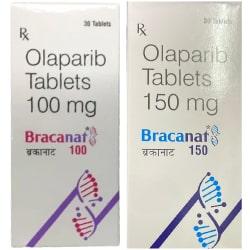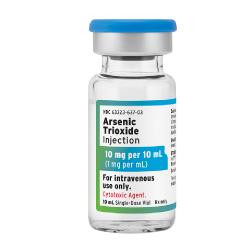Description
-
- First-Line Maintenance Treatment for BRCA-mutated Advanced Ovarian Cancer: Olaparib is utilized in the maintenance treatment of adult patients with advanced epithelial ovarian, fallopian tube, or primary peritoneal cancer carrying deleterious or suspected deleterious germline or somatic BRCA mutations, who show a full or partial response to initial platinum-based chemotherapy.
- First-Line Maintenance Treatment for HRD-positive Advanced Ovarian Cancer with Bevacizumab: Alongside bevacizumab, Olaparib is employed in the maintenance therapy of adult patients with advanced epithelial ovarian, fallopian tube, or primary peritoneal cancer, showing full or partial response to first-line platinum-based chemotherapy and linked with HRD+ve status, defined by specific genetic markers.
- Maintenance Treatment for Recurrent Ovarian Cancer: Bracanat tablet is used as maintenance therapy for adult patients with recurrent epithelial ovarian, fallopian tube, or primary peritoneal cancer, exhibiting complete or partial response to platinum-based chemotherapy.
- Treatment for Advanced Germline BRCA-mutated Ovarian Cancer After Multiple Chemotherapy Lines: In adult patients with advanced ovarian cancer harbouring deleterious germline BRCA mutations, Bracanat tablet serves as a treatment option after three or more lines of chemotherapy.
- Treatment for Germline BRCA-mutated HER2-negative Metastatic Breast Cancer: Olaparib 100 mg tablet is prescribed for adults with HER2-negative metastatic breast cancer carrying deleterious or suspected deleterious germline BRCA mutations, having undergone prior chemotherapy. For HR+ve breast cancer patients, previous endocrine therapy is required or considered inappropriate.
- First-Line Maintenance Treatment for Germline BRCA-mutated Metastatic Pancreatic Adenocarcinoma: In adults with metastatic pancreatic adenocarcinoma having deleterious/suspected deleterious germline BRCA mutations and no progression after at least 16 weeks of initial platinum-based chemotherapy, Bracanat tablet serves as maintenance therapy.
- HRR Gene-mutated Metastatic Castration-Resistant Prostate Cancer: Bracanat tablets is employed in adults with metastatic castration-resistant prostate cancer carrying deleterious or suspected deleterious germline or somatic homologous recombination repair (HRR) gene mutations, showing progression after prior treatment with enzalutamide or abiraterone.
Dosage and Side Effects of Olaparib Tablets
Dosage Instructions:
- Healthcare professionals recommend dosage of Olaparib 300 mg orally twice daily, with or without food. Patients prescribed Olaparib 150 mg tablets for mCRPC should also receive a gonadotropin-releasing hormone (GnRH) analog concurrently or have undergone bilateral orchiectomy. For moderate renal impairment (CLcr 31-50 mL/min), the Olaparib dosage should be reduced to 200 mg orally twice daily.
Administration Guidelines:
- Take Olaparib orally twice a day, approximately 12 hours apart. Swallow the tablets whole and avoid crushing, chewing, dissolving, or splitting them. Follow your healthcare provider’s instructions precisely regarding food intake. Do not exceed 4 tablets in a day.
Special Considerations for Breast and Prostate Cancer Treatment:
- For those using Olaparib for early breast cancer with hormone receptor-positive disease, maintain hormonal therapy alongside Olaparib treatment.
- In prostate cancer patients receiving gonadotropin-releasing hormone (GnRH) analog therapy, continue unless surgical castration has been performed to reduce testosterone levels.
Missed Dose and Overdose Guidelines:
- If a dose of Olaparib is missed, take the next dose at the usual time; do not double up on doses. In case of an overdose, promptly seek advice from a healthcare professional or visit the nearest hospital emergency room.
Commonly Reported Side Effects:
- The most frequently reported side effects of Olaparib as a standalone treatment include vomiting, nausea, fatigue, anaemia, diarrhoea, decreased appetite, cough, headache, neutropenia, and abdominal pain. Other reported effects encompass dysgeusia, dyspnea, dizziness, dyspepsia, leukopenia, and thrombocytopenia.
Side Effects in Combination with Bevacizumab:
-
- When used alongside bevacizumab, common side effects of Olaparib encompass fatigue, nausea, anaemia, lymphopenia, diarrhea, vomiting, neutropenia, urinary tract infection, leukopenia, and headache.
Warning and Precautions of Olaparib Tablets
- Starting Treatment and Checking Blood Counts: Don’t begin Olaparib 150 mg tablets until patients recover from prior chemotherapy blood issues. Monitor blood counts before treatment and monthly after. If blood issues persist, pause treatment, monitor weekly, and seek further evaluation if there is no improvement within four weeks.
- Respiratory Symptoms and Pneumonitis: Bracanat tablet treatment for various cancers can lead to pneumonitis. Watch for cough, breathing trouble, or fever. Stop treatment if confirmed and treat accordingly.
- Thromboembolic Events Monitoring: Patients with prostate cancer on Olaparib 100 mg tablets should watch for blood clots. Monitor and treat any signs of clots, possibly requiring long-term blood thinners.
- Pregnancy and Breastfeeding Precautions: Bracanat tablet can harm fetuses. Women using it should use contraception during treatment and for six months after. Lactating women shouldn’t breastfeed while on Bracanat tablet and for a month after the last dose.






